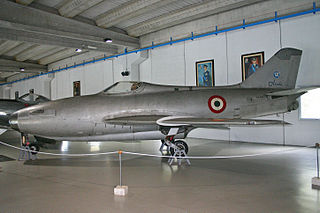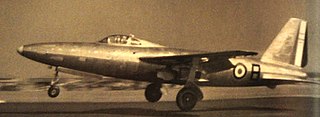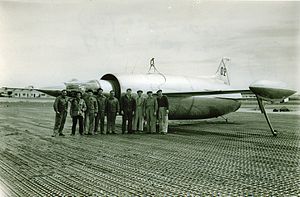
The Aerfer Sagittario 2 was a prototype all-metal single-seat lightweight fighter aircraft built in Italy by Aerfer, intended to serve as an interceptor or light tactical support aircraft. First flown in 1956, it became the first Italian aircraft to break the sound barrier in controlled flight when it reached Mach 1.1 during a dive from 13,725 m (45,000 ft).

The Aerfer Ariete was a prototype fighter aircraft built in Italy in 1958. It was a refined derivative of the Aerfer Sagittario 2, and was an attempt to bring that aircraft up to a standard where it could be mass-produced as a viable combat aircraft.

The Republic XF-103 was an American project to develop a powerful missile-armed interceptor aircraft capable of destroying Soviet bombers while flying at speeds as high as Mach 3. Despite a prolonged development, it never progressed past the mockup stage.

The Convair XF-92 was an American, delta wing, first-generation jet prototype. Originally conceived as a point-defence interceptor, the design was later used purely for experimental purposes and only one was built. However, it led Convair to use the delta-wing on a number of designs, including the F-102 Delta Dagger, F-106 Delta Dart, B-58 Hustler, the US Navy's F2Y Sea Dart as well as the VTOL FY Pogo.

The Hiller YH-32 Hornet was an American ultralight helicopter built by Hiller Aircraft in the early 1950s. It was a small and unique design because it was powered by two Hiller 8RJ2B ramjet engines mounted on the rotor blade tips which weigh 13 lb (5.9 kg) each and deliver an equivalent of 45 hp (34 kW) for a total of 90 hp (67 kW). Versions of the HJ-1 Hornet were built for the United States Army and the United States Navy in the early 1950s.

The Nord 1500 Griffon was an experimental ramjet-powered interceptor aircraft designed and built by French state-owned aircraft manufacturer Nord Aviation. The Griffon was developed to become a Mach 2 follow on to the supersonic Nord Gerfaut research aircraft. Development of the aircraft began in earnest after the receipt of a letter of intent in 1953 for a pair of unarmed research aircraft. The design featured an innovative dual propulsion turbojet-ramjet configuration; the former being used to takeoff and attain sufficient speed to start the latter.

The Leduc 0.10 was a research aircraft built in France, one of the world's first aircraft to fly powered solely by a ramjet.
The Brochet MB.120 was a two-seat light aircraft developed in France in the 1950s.

The Camair Twin Navion was a civil utility aircraft produced in the United States in the 1950s by converting single-engine Ryan Navions to twin-engine power. It had been one of two programs to improve the performance of the otherwise-pleasing Navion that was generally considered to be underpowered. The other program had resulted in the TEMCO-Riley D-16A Twin Navion. The Twin Navion design had been undertaken by the White brothers of White Engineering in San Antonio, Texas. They replaced the Navion's engine with a baggage compartment, mounted two engines within new nacelles attached to the wing leading edges, fitted the aircraft with a new tail fin made of fiberglass, and added tip tanks made from recycled WWII napalm canisters. Designated the WE-1, the prototype and the rights were sold to Camair soon after its first flight in 1953 and Civil Aviation Authority type certification was achieved in May 1955 under the name Camair 480. Sales were slow and Camair built only 25 examples before selling off the rights in 1959. The ownership of these rights would change hands twice again over the following decade but only another eight aircraft would be built after the end of Camair's involvement

The NHI H-3 Kolibrie was a small helicopter developed in the Netherlands in the 1950s by Nederlandse Helikopter Industrie. It first flew in May 1956.

The Piaggio P.148 was a 1950s Italian two-seat primary or aerobatic training monoplane designed and built by Piaggio Aero.

The Nord Gerfaut (Gyrfalcon) was a French delta-wing experimental research aircraft. It was the first European aircraft to exceed Mach 1 in level flight without the use of an afterburner. A pair of aircraft were built for the primary purpose of investigating the transonic regime. The Gerfaut I conducted its maiden flight in 1954; it was followed by the improved Gerfaut II two years later. Both aircraft were flown for several years for experimental purposes, being significantly upgraded over time. During the course of these test flights, the second prototype establishment multiple time-to-altitude world records. In the late 1950s, the type was used to flight-test various aerial missiles. Both aircraft performed their final flights in 1959; they were subsequently used as targets at the Military Test Range at Cazaux.
The Casmuniz 52 was a twin-engine light transport aircraft. It was the first all-metal aircraft built in Brazil, only the prototype was built.

The Leduc 022 was the prototype of a mixed-power French interceptor built in the mid-1950s. Designer René Leduc had been developing ramjet-powered aircraft since before World War II and had flown a series of experimental aircraft, the Leduc 0.10 and Leduc 0.21, throughout the 1950s before he was awarded a contract for two examples of a short-range supersonic interceptor armed with two air-to-air missiles (AAMs).

The Potez 75 was a low-cost, simple, ground-support, observation and launch aircraft for anti-tank missiles, designed and built in the early 1950s, for use in colonial conflicts. One hundred and fifteen were ordered in 1956, but cancelled in 1957.

The Dassault Mirage F2 was a French prototype two-seat ground attack/fighter aircraft, which was designed to serve as a test bed for the SNECMA TF306 turbofan engine. The F2 also influenced the subsequent Dassault Mirage G, a variable geometry design.

The MQM-42 was a supersonic target drone developed by North American Aviation. Developed in two subvariants, Redhead and Roadrunner, it was used by the United States Army in the 1960s and 1970s.

The Payen Pa 49 Katy was a small experimental French turbojet powered tailless aircraft, designed by Nicolas Roland Payen, and first flown in 1954. It was the first French aircraft of this kind and the smallest jet aircraft of its day.

The CSS-12 was a prototype Polish twin-engined feederliner of the 1950s. A single example was built and flown in 1950, but no production followed.

The Sud-Ouest SO.6020 Espadon (Swordfish) was a French post-war prototype interceptor designed and built by SNCASO during the late 1940s. The French Air Force judged the design a failure despite some records being set and cancelled plans to put it into service in 1951. Only four aircraft were built and they were later modified to serve as testbeds for the mixed rocket and turbojet-powered SNCASO SO.9000 Trident program. Only one badly damaged aircraft survives.


















